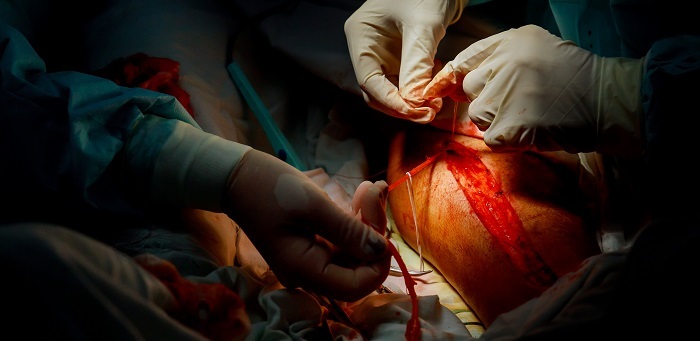
 Data Structure
Data Structure Networking
Networking RDBMS
RDBMS Operating System
Operating System Java
Java MS Excel
MS Excel iOS
iOS HTML
HTML CSS
CSS Android
Android Python
Python C Programming
C Programming C++
C++ C#
C# MongoDB
MongoDB MySQL
MySQL Javascript
Javascript PHP
PHP
- Selected Reading
- UPSC IAS Exams Notes
- Developer's Best Practices
- Questions and Answers
- Effective Resume Writing
- HR Interview Questions
- Computer Glossary
- Who is Who
What is the full form of CABG ?
Introduction
Coronary Artery Bypass Graft (CABG) is a treatment that improves the blood flow to parts of the heart that are not receiving sufficient blood. If anyone has experienced a heart attack or is at an increased risk of experiencing one shortly, this operation can improve the condition and enhance the heart's functions.

Fatty deposits within the artery walls are the root cause of Coronary artery disease (CAD). The arteries inside get congested due to this buildup, which reduces the amount of oxygen-rich blood that can reach the heart muscle.
A healthy blood vessel from another part of your body might be used to replace the affected portion of the coronary artery as a treatment for the clogged or restricted arteries. The bypass procedure may involve using blood arteries or grafts from your chest artery or leg vein.
What are the three different types of bypass grafts?
Arterial Grafts
Internal Thoracic Arteries (ITA ) ? Due to their long-term success, Internal thoracic artery bypass grafts are the most popular. There are two ITA in the chest, and because they already have their supply of oxygen-rich blood, these arteries can be left intact in their original location if used as a bypass.
-
Radial Artery (RA) ? RA is another common kind of arterial transplant. The ulnar and radial arteries are the two arteries in the arm. Most people won't experience any negative consequences if the radial artery is utilized as a graft because the ulnar artery supplies blood to the arm.
The patient must take a calcium channel blocker drug for several months following surgery if the radial artery is used as the graft. The artery is kept open by this medicine. Although the long-term effects of this type of graft are not entirely understood, it is known to have positive results.
Vein Grafts
Saphenous Veins (SPV) ? Due to its simplicity of extraction, the Saphenous vein is a vein that is frequently used for the bypass. The SPV, which runs from the top of the foot to the upper thigh and groin, is the longest vein in the human body. In the long run, vein transplants frequently fail.
Which Vein is used for CABG?
Surgeons may occasionally use the Saphenous vein to make a bypass graft that will be applied to another part of your body. This occurs during coronary artery bypass Graft.
In the legs, we have two superficial veins: the big saphenous vein and the little saphenous vein. They draw blood with low oxygen content from several tiny veins in the legs and feet. The saphenous veins transport this blood to deep veins so it can continue to flow back to the heart. The saphenous veins can be affected by varicose veins and may require treatment.
What are the complications of CABG?
Surgery involving a coronary artery bypass graft may carry the following risks ?
Bleeding during or following the procedure ? Any major procedure has a certain risk. Those who take blood thinners must stop taking them before surgery (under the direction and observation of their healthcare professional) to prevent this.
Blood clots can cause heart attack, stroke, or lung problems
Infection around the surgical site
Pneumonia
breathing difficulties
Memory loss or difficulty thinking correctly, which is frequently transient.
Stroke.
Kidney issues
If the operation is performed as an emergency procedure, there is a greater chance of difficulties.
The likelihood that an individual may experience complications after coronary artery bypass surgery depends on their overall health at the time of the procedure.
Medications are frequently administered before surgery to control bleeding, blood pressure, and infection to lower the chance of problems.
Conclusion
Coronary artery bypass grafting is a procedure that can significantly impact your average duration and quality of life, as well as how you feel. It's a serious procedure, therefore it's natural to fear or feel apprehensive before the surgery. It's crucial to speak with your healthcare practitioner because they can give you details and materials to assist you in understanding what's going on. They can also provide you with advice on how to handle situations so that you avoid problems and achieve the greatest results.
How well you manage chronic illnesses like diabetes, hypertension, and high cholesterol will determine the results and overall outcome. It's crucial to take your medications exactly as prescribed.
FAQs
Q1. How long does it take to recover after CABG?
Ans. Most Coronary artery bypass graft patients take several weeks to recover entirely from this treatment. The doctor would probably advise you to avoid any demanding activities or scenarios that could place too much strain on your heart and scars at that period.
Q2. What are the lifestyle changes one can adapt for better heart health?
Ans. Look for strategies to lessen emotional stress. It might be beneficial to engage in mindfulness exercises and socialize with others in support groups. Consult your healthcare practitioner about coping mechanisms if you have depressive disorders or fear, The risk of heart disease and other chronic diseases may rise as a result of poor sleep. People should try to sleep at least 7 to 9 hours every night.
Q3. What is the mortality risk of having a bypass?
Ans. Following a coronary artery bypass graft, infections could develop in your chest, arm, or leg. Infection after a coronary artery bypass transplant can harm your lungs or the inside of your chest.

